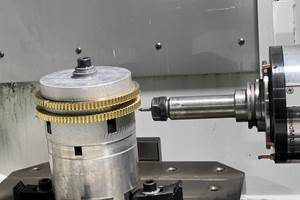For Many Machining Facilities, the Mindset Now Must Be “Radical Automation”
What if there will never, ever be enough talent in your local labor pool to meet the still-growing demand for skilled manufacturing employees? The real challenge might lie in our expectations about how much skilled labor we need. Let IMTS 2018 be the beginning of facing this challenge.
Share




.png;maxWidth=45)
DMG MORI - Cincinnati
Featured Content
View More



Takumi USA
Featured Content
View MoreThink “radical automation.” In 2018, I believe these two words capture the aim and the mind-set many shops will need to bring to the International Manufacturing Technology Show (IMTS). The value of the event is not just in evaluating technology for today’s pressing needs but also discovering the ideas that will be at the heart of meeting a shop’s needs five to eight years from now. And across that window of time, one of those needs is almost certain to be delivering more output using the same or fewer skilled employees.
Our industry has been talking about the “shortage” of skilled employees with the same urgency for almost 10 years now. We’ve been talking about it since the start of the rebound from the Great Recession, and efforts in this area have shown success: CNC programs in community colleges are now far more popular than they once were. Yet even these gains are not enough to keep up as older employees retire and manufacturing activity continues to advance. We might have to accept that we will never have enough skilled manufacturing employees in the labor pool to keep pace with expanding processes that continue to assume today’s ratio of people to production. Therefore, it is time to change those processes, and it is time to change the ratio.
This gets to why I placed the word “shortage” in quotation marks. The so-called shortage of skilled employees exists only because of today’s assumptions and requirements as to how much staff is needed to deliver a given output. For any particular shop, I do not know what the elements will be of the future process that will enable that shop to change its staffing assumptions and requirements, but I do believe the core technologies are already out there to be found.
That’s why, when I speak of radical automation, I mean it in two ways. One is a radically greater commitment to automation than the team in your facility might have ever imagined seeing. The other is a radically expanded sense of what automation might include. It will probably include robots, yet robots alone likely are not enough. What else can omit significant labor? Multitasking is potentially automation. Additive manufacturing is automation, too, offering the chance to avoid the labor-intensive step of assembly. A more extensive commitment to CNC machining is also automation if it reduces the reliance on a near-net-shape process such as casting. And trying to figure out the possibilities of the Industrial Internet of Things (IIoT) offers avenues to automation yet to be explored.
All this will take time. Much of the work of getting from today’s point A to tomorrow’s point B will proceed slowly and will seem unproductive because it will consist of gathering important facts, challenging limited thinking and formulating a strategy to realize a new vision for production that is sufficiently big enough to meet the scope of opportunity your shop faces. So the time to begin is soon, and perhaps the perfect place to begin is this fall’s event in Chicago. In your pursuit of radical automation, let the first step be a radical rethinking of your goals for IMTS.
Related Content
Cutting Part Programming Times Through AI
CAM Assist cuts repetition from part programming — early users say it cuts tribal knowledge and could be a useful tool for training new programmers.
Read MoreWhich Approach to Automation Fits Your CNC Machine Tool?
Choosing the right automation to pair with a CNC machine tool cell means weighing various factors, as this fabrication business has learned well.
Read MoreFour-Axis Horizontal Machining Doubles Shop’s Productivity
Horizontal four-axis machining enabled McKenzie CNC to cut operations and cycle times for its high-mix, high-repeat work — more than doubling its throughput.
Read MoreSame Headcount, Double the Sales: Successful Job Shop Automation
Doubling sales requires more than just robots. Pro Products’ staff works in tandem with robots, performing inspection and other value-added activities.
Read MoreRead Next
Registration Now Open for the Precision Machining Technology Show (PMTS) 2025
The precision machining industry’s premier event returns to Cleveland, OH, April 1-3.
Read MoreBuilding Out a Foundation for Student Machinists
Autodesk and Haas have teamed up to produce an introductory course for students that covers the basics of CAD, CAM and CNC while providing them with a portfolio part.
Read More5 Rules of Thumb for Buying CNC Machine Tools
Use these tips to carefully plan your machine tool purchases and to avoid regretting your decision later.
Read More
















.png;maxWidth=150)



























